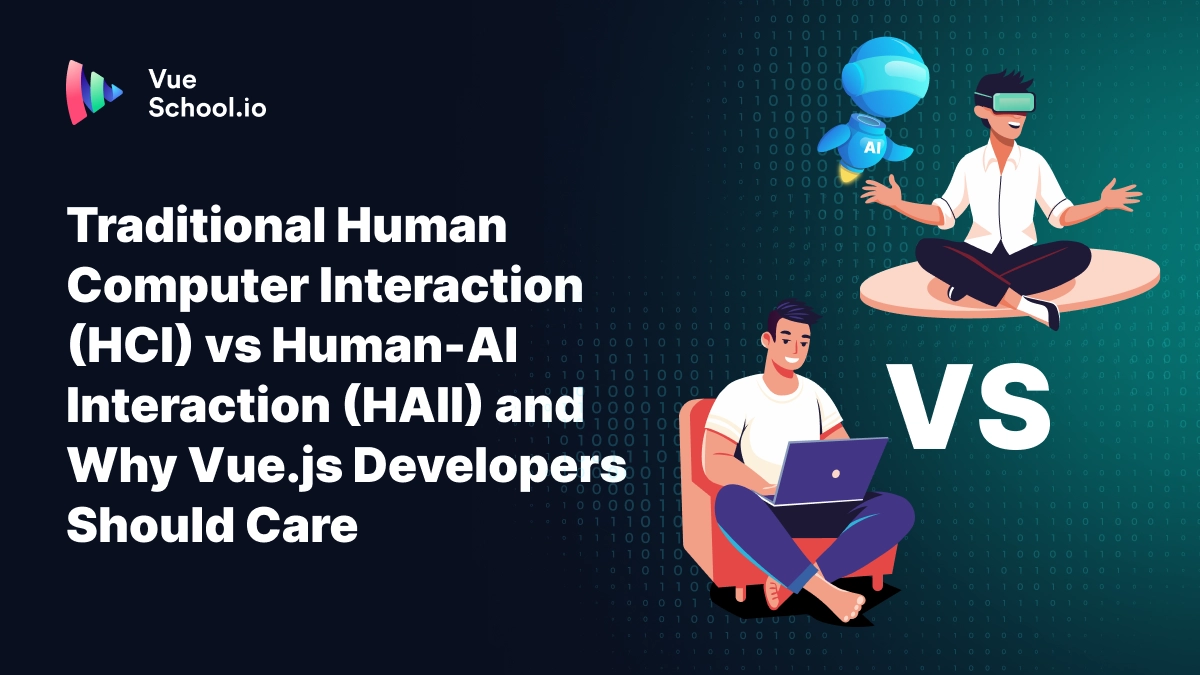Traditional Human Computer Interaction (HCI) vs Human-AI Interaction (HAII) and Why Vue.js Developers Should Care

Introduction
As Artificial Intelligence (AI) transforms web applications, Vue.js and Nuxt.js developers are tasked with crafting interfaces that go beyond traditional user experiences. Human-Computer Interaction (HCI) has long guided the design of predictable, static interfaces, like form submissions in a Vue.js app.
However, Human-AI Interaction (HAII) introduces dynamic, collaborative systems—think AI-powered chatbots or recommendation engines embedded in Nuxt.js platforms. Understanding the shift from HCI to HAII is vital for building intuitive, trustworthy AI-driven features that delight users.
This guide explores the differences between HCI and HAII, key design challenges, and why Vue.js developers should embrace HAII to create cutting-edge web experiences in 2025.
After reading this article, you’ll:
- Grasp the core differences between HCI and HAII.
- Learn key HAII design challenges and solutions for Vue.js projects.
- Discover how to integrate AI interfaces into Vue.js and Nuxt.js apps.
- Gain insights into building trust and control in AI-driven web experiences.
HCI vs. HAII: A Fundamental Shift
Human-Computer Interaction (HCI) focuses on designing predictable interfaces where user actions yield consistent results. In a Vue.js app, clicking a button to submit a contact form triggers a predefined response, like a success message. HCI relies on static, rule-based systems, ensuring users know what to expect. Designers craft clear navigation flows, making interfaces intuitive and reliable.
Human-AI Interaction (HAII), by contrast, involves dynamic, collaborative exchanges with AI systems. Imagine a Vue.js e-commerce site with a ChatGPT-powered chatbot. A user types, “Suggest products for a cozy evening,” and ChatGPT generates tailored recommendations based on context, training data, and probabilistic logic. Unlike HCI’s fixed outputs, HAII’s responses vary, adapting to user tone or intent. This flexibility enables personalized experiences but challenges developers to manage unpredictability in Vue.js interfaces.
- HCI Characteristics:
- Predictable, static outputs.
- Predefined user flows.
- Focus on usability and consistency.
- HAII Characteristics:
- Dynamic, context-driven outputs.
- Probabilistic, collaborative responses.
- Emphasis on adaptability and trust.
For Vue.js developers, HAII means rethinking UX to accommodate AI’s fluid nature, ensuring seamless integration into web apps.
Why HAII Matters for Vue.js Developers
HAII offers Vue.js and Nuxt.js developers opportunities to build smarter applications. AI-driven features, like chatbots or personalized dashboards, enhance user engagement in Vue.js storefronts or Nuxt.js content platforms. For instance, integrating a ChatGPT-powered assistant into a Vue.js blog can provide real-time content suggestions, boosting interactivity.
However, HAII’s complexity—dynamic outputs, uncertainty, and collaboration—requires new design strategies. Poorly designed HAII can confuse users, erode trust, and harm usability, especially in web apps where seamless UX is critical. By mastering HAII, Vue.js developers can create innovative, user-centric experiences that stand out in 2025.
Key Challenges in HAII Design
Designing HAII for Vue.js apps involves three core challenges: explainability, user trust, and user control. Each impacts how users interact with AI-driven features, demanding thoughtful UX solutions.
Explainability: Why Did the AI Respond This Way?
AI systems often act as “black boxes,” hiding their decision-making processes. In a Vue.js app with a Grok chatbot, a user might ask, “Why did you recommend this product?” Without clear reasoning, users feel frustrated, unsure how to refine their inputs. Explainability ensures the AI clarifies its logic, enhancing collaboration.
For example, Grok might respond, “I suggested this item based on your recent searches, with a 90% match to your preferences.” Displaying a “Thinking…” indicator while processing, followed by a breakdown of the recommendation logic, helps users understand the AI’s actions. Vue.js developers can design interfaces with visual cues—like tooltips or status bars—to make AI reasoning transparent, improving UX.
User Trust: Is the AI Reliable?
Trust is the cornerstone of HAII, as users must rely on AI outputs for collaboration. In a Nuxt.js app using ChatGPT for content analysis, users expect accurate insights. Early AI tools struggled with “hallucinations,” generating false information without sources. Modern systems, like Claude or DeepSeek in 2025, include citations, but trust hinges on clear presentation.
Vue.js developers can enhance trust by:
- Separating AI responses from source links with icons or hyperlinks.
- Displaying confidence scores (e.g., “This analysis is 85% accurate based on your data”).
- Allowing feedback to refine AI performance.
These elements ensure users trust AI-driven features, fostering engagement in Vue.js apps.
User Control: Can Users Steer the AI?
AI’s autonomy can feel overwhelming if users lack control. In a Vue.js portfolio with a ChatGPT-powered design assistant, users might request, “Generate a layout.” If the AI produces an undesired result without adjustable options, users feel stuck. Effective HAII design empowers users to guide outcomes.
For instance, a Vue.js interface could include sliders to tweak AI-generated layouts or a “Stop” button to halt processing. Progress bars showing “Generating…” or “Refining…” keep users informed, while version history lets them revert changes. These controls make AI collaboration intuitive, aligning with Vue.js’s user-friendly ethos.
HAII Design Challenges:
- Explainability: Clarifying AI decision logic.
- Trust: Ensuring reliable, sourced outputs.
- Control: Empowering users to steer AI actions.
Solutions for HAII Usability in Vue.js Apps
To address HAII challenges, Vue.js developers can adopt UX strategies that enhance usability, drawing from emerging best practices.
Confidence Scores and Visual Aids
Confidence scores quantify AI reliability, making outputs digestible. In a Vue.js e-commerce app, a recommendation system might say, “These products match your style with 92% confidence.” Heatmaps or gradient colors—red for low confidence, green for high—visualize probability, aiding user interpretation. These elements, integrated into Vue.js components, clarify AI behavior without overwhelming users.
Progress Bars and State Indicators
AI processes involve multiple states (e.g., “Thinking,” “Generating”). In a Nuxt.js content app, a ChatGPT-driven article generator could display a progress bar labeled “Drafting Content…” to signal activity. Vue.js developers can use dynamic components to reflect these states, ensuring users know the AI’s status, reducing confusion.
Error Management
AI errors are common, but transparent handling builds trust. If a Grok chatbot in a Vue.js app misinterprets a query, it should admit, “I misunderstood—can you clarify?” and suggest alternatives. Vue.js interfaces can include error alerts with actionable prompts, guiding users to resolve issues collaboratively.
Usability Solutions:
- Confidence scores for transparency.
- Heatmaps/gradients for probabilistic outputs.
- Progress bars for state clarity.
- Transparent error handling with user guidance.
Diagram: HAII Workflow in Vue.js Apps
[User Input: Prompt in Vue.js App]
|
v
[AI Processing: "Thinking..."]
|
v
[State Indicator: Progress Bar]
|
v
[Output: AI Response + Confidence Score]
|
v
[User Control: Adjust/Feedback]This diagram shows how a Vue.js app handles HAII, from input to controlled output.
Future of HAII for Vue.js Developers
HAII is set to grow in 2025, with trends like:
- Enhanced explainability through visual tools.
- Stronger trust via robust sourcing.
- Greater control with interactive AI interfaces.
- Wider adoption of conversational UIs in web apps.
For Vue.js and Nuxt.js developers, mastering HAII means building innovative, user-centric apps that leverage AI’s potential while ensuring usability. Staying updated via communities like VueSchool.io prepares you for this shift!
Conclusion
The transition from HCI to HAII marks a new era for developers, offering opportunities to create dynamic, AI-driven web experiences. By addressing HAII’s challenges—explainability, trust, and control—you can build intuitive features like Claude-powered chatbots or ChatGPT-driven analytics in Vue.js apps. If you’re looking to elevate your skills and to better incorporate AI into your workflow, learn how to be an AI-driven developer with this comprehensive course powered by Bitter Brains.
Start learning Vue.js for free

Comments
Latest Vue School Articles
Just Released: Nuxt Hub Multi-Vendor and First-Class DB

Vue.js – 2025 In Review and a Peek into 2026

Our goal is to be the number one source of Vue.js knowledge for all skill levels. We offer the knowledge of our industry leaders through awesome video courses for a ridiculously low price.
More than 200.000 users have already joined us. You are welcome too!
© All rights reserved. Made with ❤️ by BitterBrains, Inc.



